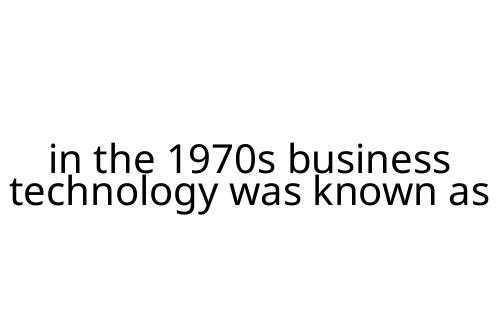in the 1970s business technology was known as
In the 1970s, business technology was known as "data processing." Back then, the term didn't conjure images of laptops or cloud computing. Instead, it was all about mainframes, punch cards, and batch processing. For organizations, having a dedicated data processing department was a sign of modernity—long before the age of personal computers.
What Did Business Technology Mean in the 1970s?
Data processing referred to the use of electronic machines to handle business tasks involving large amounts of information. This usually meant payroll, inventory management, or accounting. Most businesses relied on mainframe computers—massive, room-sized machines that handled operations once managed by hand or with simple calculators.
Computers weren’t on every desk. In fact, most employees never interacted with them directly. Instead, specialists worked in climate-controlled rooms, feeding machines stacks of punch cards. These cards contained the raw data to be processed overnight or in scheduled "batches." The results, often printed out on wide, green-and-white paper, would be used by management to make decisions.
How Did Businesses Use Technology?
Data processing was both powerful and limited. On the plus side, tasks that once took teams of clerks days to complete could be handled much faster. Payroll could be calculated and checks printed with fewer errors. Inventory levels could be tracked reliably, reducing shortages or overstock.
However, the system was far from agile. Getting useful data required planning and patience. Making changes to how data was processed might mean rewriting custom programs or physically re-punching thousands of cards. There was no real-time reporting; everything was scheduled and rigid.
Key Technologies of the Era
- Mainframe Computers: IBM led the market, with systems like the IBM System/370. These powered the majority of Fortune 500 businesses.
- Punch Cards: Stiff, rectangular cards with holes punched in predefined spots, each representing one character or number. Essential for input.
- Magnetic Tape: Used to store vast amounts of data cost-effectively and reliably.
- Batch Processing: Tasks were completed in groups—no instant processing or ad-hoc analysis.
The Pros and Cons
Pros:
- Significant gains in speed and accuracy over manual methods
- Ability to manage large datasets
- Foundation for further automation
Cons:
- High cost—mainframes and trained staff were expensive
- Lack of flexibility—changing processes took time and expertise
- Limited access—most employees never saw the technology in action
How It Set the Stage for the Future
While the phrase "business technology" wasn’t common yet, the groundwork was being laid for advances to come. As microprocessors and minicomputers gained traction in the late ’70s, the seeds for today’s technological landscape were sown. Data processing evolved into IT (information technology), and eventually into the digital, networked environments businesses rely on today.
Final Thoughts
In the 1970s business technology was known as data processing. It was an era of closed-off computer labs, punch cards, and batch systems. Despite its limitations, early business technology transformed the way companies operated—proving that automation and computerization could change the very nature of work.

 Donemic Grantnurry, founder of the Avant Garde Artistry Hub, is a visionary at the intersection of art and technology. With a deep passion for innovation, Donemic has created a platform that not only informs artists about the latest tools and trends but also empowers them to transform their creative processes. His dedication to exploring the therapeutic potential of art has positioned Avant Garde Artistry Hub as a key resource for artists seeking to improve both their craft and well-being.
Beyond his work in art technology, Donemic is committed to helping artists build sustainable careers. Through insightful articles on marketing, business strategies, and art competitions, he provides emerging talents with the guidance they need to succeed in the competitive world of art. His work continues to inspire and support a global community of creatives who are passionate about blending art with modern technology.
Donemic Grantnurry, founder of the Avant Garde Artistry Hub, is a visionary at the intersection of art and technology. With a deep passion for innovation, Donemic has created a platform that not only informs artists about the latest tools and trends but also empowers them to transform their creative processes. His dedication to exploring the therapeutic potential of art has positioned Avant Garde Artistry Hub as a key resource for artists seeking to improve both their craft and well-being.
Beyond his work in art technology, Donemic is committed to helping artists build sustainable careers. Through insightful articles on marketing, business strategies, and art competitions, he provides emerging talents with the guidance they need to succeed in the competitive world of art. His work continues to inspire and support a global community of creatives who are passionate about blending art with modern technology.